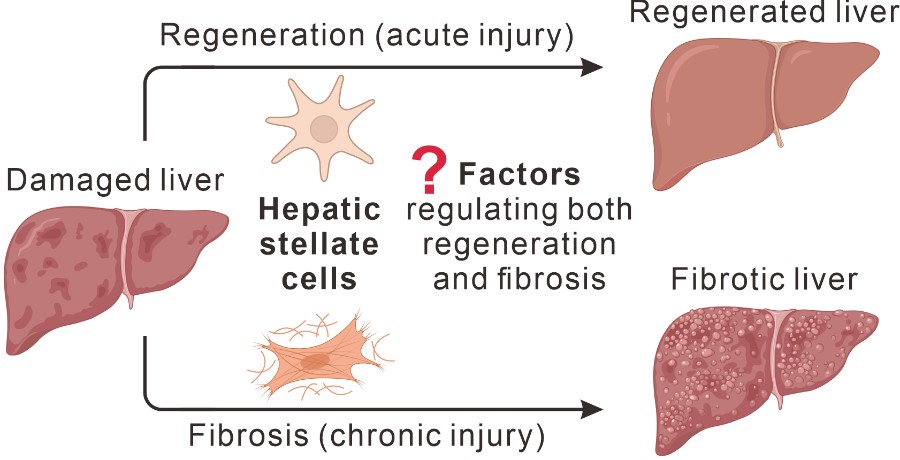The research team of GIBH discovered the target gene Lhx2 in hepatic stellate cells regulating liver regeneration and fibrosis
Recently, the research teams of WANG Jie and LI Yinxiong from the Guangzhou Institutes of Biomedicine and Health, Chinese Academy of Sciences (GIBH, CAS), in collaboration with YUAN Shengxian's team from the Eastern Hepatobiliary Surgery Hospital, affiliated with the Second Military Medical University, published a research paper titled "Lhx2 specifically expressed in hepatic stellate cells promotes liver regeneration and inhibits liver fibrosis" in Hepatology. This study revealed that the transcription factor Lhx2, specifically expressed in hepatic stellate cells, plays a role in simultaneously promoting liver regeneration and inhibiting liver fibrosis.
The liver is the solid organ with the greatest capacity for regeneration in the human body. However, sustained chronic liver injury can significantly impair the regenerative capacity of liver, leading to the development of liver fibrosis. Hepatic stellate cells (HSCs), as the major mesenchymal cells in the liver, play an important role in both liver regeneration and fibrosis. However, it remains unclear whether there are specific target genes in HSCs that can simultaneously promote liver regeneration and inhibit liver fibrosis.

Figure. Hepatic stellate cells play an important role in regeneration and fibrosis after liver injury, but the target genes that simultaneously regulate both processes in hepatic stellate cells are not yet clear (Image by Prof. WANG's team)
In this study, the researchers first compared the liver pathological phenotypes and the expression profiles of hepatic stellate cells (HSCs) during the repair phase after acute and chronic liver injury. They found that HSCs might be the key to regulate liver regeneration and fibrosis after injury. Through differential transcription factor screening and analysis of public single-cell transcriptomic data, they preliminarily identified the transcription factor Lhx2 (LIM homeobox protein 2) in HSCs as having dual functions in regulating liver regeneration and fibrosis. The researchers then used RNA-seq and CUT &Tag to further explore the downstream molecular targets of Lhx2. The results showed that Lhx2 upregulates the expression of various regenerative factors and inhibits the expression of genes associated with HSC activation.
To verify the function of Lhx2 at the animal level, the team constructed acute and chronic liver injury models in mice induced by CCl4. By injecting modified si-RNAs, they confirmed that knocking down Lhx2 inhibited hepatocyte proliferation and liver function recovery following acute liver injury. In addition, they used Lrat-cre (HSC-specific cre) mice and AAV8-DIO-mLhx2 virus to specifically overexpress Lhx2 in HSCs, further validating that HSC-specific overexpression of Lhx2 promoted liver regeneration and repair after acute liver injury and inhibited fibrosis following chronic liver injury. At the molecular level, the study revealed that Lhx2 primarily promotes hepatocyte proliferation by targeting and up-regulating the expression of HGF in HSCs, thereby promoting liver regeneration. Moreover, Lhx2 inhibited HSC activation and fibrosis by up-regulating SMAD6, which blocks the TGF-β signaling pathway in HSCs.
In summary, this study systematically revealed the important functions of HSCs in liver regeneration and fibrosis at the molecular, cellular, and animal levels, and elucidated the molecular mechanism by which the specific transcription factor Lhx2 regulates liver regeneration and fibrosis. This provided new targets and insights for the treatment of liver diseases.
TAO Jiawang, WU Zichao, LIANG Yanran, WANG Jiongliang, and TANG Miaoxiu from GIBH, CAS, are the co-first authors of the paper. WANG Jie and LI Yinxiong from GIBH, CAS, and YUAN Shengxian, an associate professor at the Eastern Hepatobiliary Surgery Hospital, Second Military Medical University, are the corresponding authors. The study was supported by the National Key R&D Program, the National Natural Science Foundation, and the Guangdong Provincial Science and Technology Program, among others.
Contacts:
WANG Jie, Ph.D., Principal Investigator;
Guangzhou Institutes of Biomedicine and Health, Chinese Academy of Sciences, Guangzhou, China, 510530.
Email: wang_jie01@gibh.ac.cn
Attachment Download:
-
ContactWANG Jie, Ph.D.wang_jie01@gibh.ac.cn
-
Reference
-
Related Article